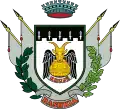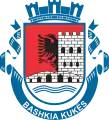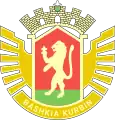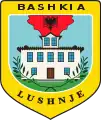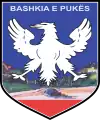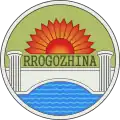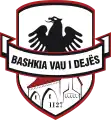Heraldry, as a scholarly discipline that deals with the study and origin of various symbols and elements, emerged in Albania towards the end of the 13th century. Over time, it has evolved as an inseparable component of European heraldry, encompassing its advancements, shifts and accomplishments.
The earliest evidence in the usage of coats of arms can be traced to the formative period of the Principality of Arbanon, with the Gropa ruling family. This practice continued in uninterrupted succession across various medieval Albanian lineages and patronymic families, namely the Albani, Angeli, Arianiti, Balsa, Beçikemi, Dukagjini, Durazzo, Dushmani, Kastrioti, Mataranga, Muzaka, Skura, Spani, Spata, Thopia, Zaharia, Zenevisi and numerous others.[1]
Medieval rule
| Coat of arms | Description |
|---|---|
 |
Coat of arms at the Abbey of Ndërfandina (????) Within the marble beam that held the gate of the monastic cell, at the old abbey of Ndërfandina in Gëziq, the Austrian consul in Shkodër, Theodor Ippen, unearthed an epigraphic inscription from the architrave of the Basilica along with a heraldic coat of arms which featured a stone-carved eagle, with one head and two wings outstretched in flight, clutching a ring on its beak. In 1967, digging through the broken fragments which had been stored at the local museum of Rrëshen, researcher Dhimitër Shuteriqi became convinced that the pieces on the inscription formed the words DIMITRI and PROGON, in reference to the princes of the Progonate family of lords that ruled over the territory now known as the Principality of Arbanon.[2] The fragments discovered in Gëziq were transferred to the Archaeological Museum of Tirana in 1981, to be further examined by conservation specialist Koço Zheku. After meticulously reconstructing the eight pieces of marble, which collectively measured 1.6 meters in length, Zheku managed to decipher the inscription as follows:[3]
His conclusive work, refuting the earlier findings by Shuteriqi, was published in the scientific periodical "Iliria", issue nr.2, p. 219–225, year 1984. At the insistence of government officials, the inscription, unreadable in its entirety, was given a new interpretation by scholar of antiquity Injac Zamputi, reaffirming Shuteriqi's previously ambiguous claims.[4] |
 |
Coat of arms of Drivastum (????) Not far from the gates of the citadel of Drivastum, a hewn stone bearing a coat of arms was found by local peasants among the rubble and blocks of stone.
No inscription has been found to give clues as to whether the coat of arms belonged to a Venetian or an Albanian lord. One can only assume that the stone was immured in the gate and tumbled down when the wall collapsed. The coat of arms is one of the few remnants of value where once stood the medieval city of Drivastum.[5] |
 |
Coat of arms of the Gropa (1273) This coat of arms is thought to be linked to the Gropa family of feudal lords. Historical records from the 13th century reveal that the Gropa possessed vast territories in Upper Dibër, including the fertile plain of Maqellarë. One prominent member of the family, Pal Gropa, earned the prestigious title of Sevast from the Byzantine emperor Paleologus. An official document dated May 18, 1273, attests to his ownership of several villages along the Ebu River valley (present-day Bulqizë), making him a notable benefactor in Arbanon.
|
 Clockwise: Pilika's models (14th century and later); Petronio's model (1680); Fojnica's model (17th century) |
Coat of arms of the Dukagjini (14th century) The Dukagjini were a noble Albanian family of feudal lords that ruled parts of northern Albania and western Kosovo throughout the 14th and 15th centuries. A branch of the family fled Ottoman rule and settled in the Venetian-controlled city of Capodistria, joining other Albanian nobility, the Borisi, Bruni and Bruti.[7] Their extensive lineage is documented in Prospero Petronio's manuscript titled "Memorie istoriche sacre e profane dell'Istria e sua metropoli (1680–1681)", which traces the family's roots to Iginus Comnenus, of the Arianiti Comneni clan.[8] Lek Dukagjini, a strong tribal chieftain, gained prominence for his work The Kanun, a set of traditional customary laws that regulated clan relations between the highlanders of northern Albania. His nephew, Giovanni, son of Demetrio, became castellan lord of San Servolo. Other members of the family gradually integrated into Ottoman suzerainty, finding their way to Istanbul where they would achieve high ranks, beginning with Dukaginzade Ahmed Pasha who served as Grand Vizier of the Ottoman Empire from 1514 to 1515 CE. His son, Dukaginzade Mehmed Pasha, went on to great feats of his own, becoming governor of Egypt from 1554 to 1556 CE. The city of Aleppo even has a Mosque complex bearing his name. Dukaginzade Yahya Bey, a warrior-poet, or sâhib-i seyf ü kalem (master of the sword and pen), took part in key battles, including Chaldiran in 1514, the Ottoman-Mamluk War in 1516–1517 CE, and the Siege of Szigetvár in 1566 CE. Yahya Bey was celebrated as a prolific diwan poet during his lifetime. The earliest artistic depiction of the Dukagjini coat of arms was discovered in a 14th-century manuscript, later featured in a correspondence article by scholar of antiquity Dhimtri Pilika, titled "Shqiponja Arbërore si Simbol i Dukagjinëve", published in issue nr.6 (7th annual edition) of the monthly socio-political and literary arts periodical YLLI.[9] A somewhat comparable coat of arms is also found in a colored miniature dating from the 17th century Fojnica Armorial.
|
 |
Coat of arms of the Cernovichio (14th century) The Cernovichio were a noble family of feudal lords that ruled over the territory in what is now southern Montenegro and northern Albania, during the 14th century. They formed blood ties through marriage with several prominent Albanian families of the time, namely the Zaharia, Kastrioti, Arianiti, Thopia and Zaguri. Historian Demetrio Franco mentions them along the same line as other Albanian noble families, the Dukagjini, Spani and Dushmani, in his 1584 work titled "Gli Illustri et gloriosi gesti, et vittoriose imprese fatte contra Turchi; dal Sign. Giorgio Castriotto detto Scanderbego.[10] The Cernovichio are referred to as a family from Albania in the 1780 biographical dictionary titled "Dizionario Storico-Portatile di Tutte Le Venete Patrizie Famiglie", published in Venetia by Giuseppe Bettinelli.[11] Eugène Müntz writes in "Les Arts à la cour des Papes pendant le XVe et le XVIe siécle", published in 1878, the following:[12]
In the 11th annual edition of the genealogy journal "Rivista del Collegio Araldico," published in Rome in 1913, a segment of the family who had migrated to Venetia are recognized as medieval Albanian princes.[13]
|
 |
Coat of arms of the Statutes of Scutari (1330–1469) The original manuscript of the Statutes of Scutari is inscribed on parchment and contains 40 pages. Positioned at the uppermost part is depicted the coat of arms of the city of Scutari.
An interpretation of the symbolism reveals a proud vulture, signifying the city's affluent past. The craving canine appears content with the bone it receives — a metaphorical representation of Scutari's subjugated state following the Ottoman conquest.[16] |
 |
Coat of arms of the Balsa (14th century) The Balsa were a medieval dynasty of sovereigns that held ownership over the region around the east shore of Lake Scutari. In 1362, Balsa the Elder bequeathed to his sons the territory of Zeta and the coast from Budua down to Antivari, extending to Scutari, which would later become their capital. Efforts to expand south were met with opposition by the Thopia (1364), a noble family from Central Albania, who were related to the Balsa (Karl Thopia had wed Vojsava, a daughter of Balsa the Elder). Balsa II, "Sovereign of Albania", acquired Avlona and Berat by way of marriage. The Thopia eventually defeated him at the Battle of Savra in 1385. Georgio II had to relinquish his main territory, Scutari, to Venetia in 1396, unable to withstand the Ottoman incursions and the continuous internal friction. In Du Cange's work, the Balsa are described as nobles of Albania.[17] Johann Siebmacher classifies them as Albanian under the Dulcigno list of families, in his catalog of coats of arms, (vol.4) reissued in 1873.[18] The Balsa coat of arms is depicted in successive order, after those of the Kastrioti and Cernovichio, in the 17th century Fojnica Armorial.[19]
|
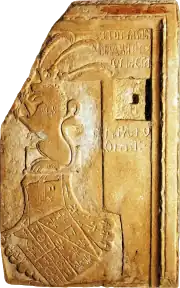 |
Coat of arms of Karl Thopia (1381) Consul General Georg v. Hahn, mentions in his work "Albanesische Studien" (p. 119) that in the monastery of St. John Vladimir, near Elbasan, an old stone was found, embedded within the church's outer wall, depicting a coat of arms, identified by an inscription as belonging to Karl Thopia.[20]
Karl Thopia ruled much of Central Albania, encompassing the area between the Mat and Shkumbin rivers from 1359 to 1387. His father, Andrea, had wed the illegitimate daughter of Robert of Anjou, king of Naples. For this reason, he incorporated the Anjou symbols, featuring lilies, into his coat of arms, visible on the left side. The bendlet traversing the field is the symbol of bastardy according to heraldic tradition.[21] |
 |
Coat of arms at the Monastery of St. Antonius (15th century) Opposite the town of Alessio, above a hill on the right bank of the Drin river, stands the small Franciscan monastery of St. Antonius. Tradition of the Franciscan order alludes to the founding of this monastery being ascribed to its founder, Francis of Assisi, going back to the 13th century. At the entrance, embedded on the pavement, a tombstone decorated with a coat of arms was found, and later removed, placed alongside the interior wall. The coat of arms is surmounted by an inscription, which is, unfortunately, incomplete.[22] It reads:
The name of the person buried here is not clear from the inscription. The tombstone probably belongs to a Venetian lord, dating from the 15th century, since Alessio was Venetian property at the time.
In contemporary Albanian history, this coat of arms is speculatively attributed to one Anton Skura, a supposed patriarch of the noble Skura family, which held sway over the territories in nearby Delbnisht, present-day Kurbin. No reliable records of an Anton Skura from sources of antiquity have been found. |
  Clockwise: Official seal (1466); Du Cange's model (1680); Fojnica's model (17th century); Schirò's model, in color (1904) |
Coat of arms of the Kastrioti (1451–1904) The coat of arms of Skanderbeg with the double-headed eagle appears for the first time in a book of greetings given to Skanderbeg by Alfonso V, King of Naples, on the occasion of the signing of the Treaty of Gaeta on 26 March 1451.[23] It was handed over by the king's protonotary, Arnaldo Fonoleda, to the ambassadors of Skanderbeg who signed this treaty, Bishop Stefan of Kruja and Father Nikola Berguci. The representative symbol of the state of Skanderbeg appears again in a Venetian catalog of coats of arms in 1463, when Gjon Kastrioti II, Skanderbeg's son, received the title "Noble of the Republic". The colors in the coat of arms are mentioned in Marin Barleti's "The history of the life and deeds of Scanderbeg, Prince of Epirus" (Latin: Historia de vita et gestis Scanderbegi Epirotarvm principis), page XV, published in 1508 – «nā rubea uexilla nigris/& bicipitibus distincta aquilis (id gētis insigne erat) gerebat Scanderbegus».[24] The usage of the same colors is later reaffirmed in Giammaria Biemmi's work "The History of Giorgio Castrioto Scander begh" (Latin: Istoria di Giorgio Castrioto detto Scander begh) who quotes the Antivarino of Bar in page 22, published in 1756 – «L'insegna di Scander begh era un' aquila negra distincta in due teste sopra campo rosso».[25] A widely adopted variation of the coat of arms comes from an illustration found in Giuseppe Schirò's 1904 book "Gli Albanesi e la Questione Balkanica".[26] The defining elements of the coat of arms are a red lightly bordered shield, in the form of a couché, a blue spherical triangle, a golden hexagram and the crowned black double-headed eagle. Monthly publication "Ylli" magazine, in its 3rd annual edition, issue no.11, dated November 1962, published an article (p. 26–27) by Dhimitri Pilika [sq], a noted scholar of pelasgian antiquity, titled "Searching for "ALBANICA" through foreign archives and libraries...". The article references the official seal of Skanderbeg being discovered in Prague, Czechoslovakia, in 1961, by the widow of Stanislav Kostka Neumann, a czech writer and expert in Albanian studies. It was part of the materials belonging to slovak philologist Pavel Jozef Šafárik, who in turn had acquired them from the Ragusa Archives. Dating back to the year 1466, the seal is portrayed as such:[27]
The image of the seal graces the surface of the purple carpet inside the reception hall of the Prime Minister's office. |
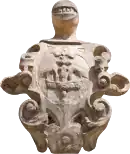 Coat of arms   Armorial |
Coat of arms of the Muzaka (1476–1514) In 1336, Andrea II Muzaka gained recognition as "Despot" of his dominion by the Kingdom of Naples. In acknowledgment of this, King Robert of Anjou entrusted his nephew, Prince Luigi, to perform the act of recognition, which extended to the inclusion of the nobleman's coat of arms on the chancellery seal.[28] The earliest artistic depiction of the Muzaka coat of arms can be found in bas-relief on the residence wall of Palazzo Argentina, located in San Giovanni street, Francavilla Fontana, province of Salentina, Italy.[29]
Symbols attributed to the Muzaka can also be found in the armorial carved from stone, inside the Church of Santa Maria della Misericordia, in Mesagne.[30]
|
 |
Coat of arms of the Arianiti (1550) Constantino Arianiti, better known as Constantinus Cominatus, was born around 1456, the son of Georgio Arianiti, an Albanian feudal lord, ruler of Cermenica, Mochino and Spatenia, who greatly contributed in the wars against the Ottomans. Georgio formed blood ties through marriage with the Kastrioti, Dukagjini and Cernovichio, although, there are no reliable accounts connecting his family to that of the Byzantine Komnenoi. Georgio Arianiti died circa 1463 and soon his possessions were taken hold by the Ottomans. His wife and sons found refuge on lands that belonged to Venetia, who in turn, recognized them as patrician dignitaries. Constantino aprenticed at the papal court in Rome, where he became an apostolic prothonotary. Later he married Francesca of Montferrat, who came from a side branch of the house of Palaiologos, which brought him several castles as dowry. Self-styled Duke of Achaea and Prince of Macedon, Constantino aspired to become leader of the Balkan Christians in the impending crusade against the Ottoman armies and even planned to assemble a fleet, which never set sail. In 1514, Pope Leo X appointed him governor of Fano, near Ancona, on the Adriatic coast.[31]
|
 |
Coat of arms of the Toptani (1760) The Toptani were a wealthy land-owning family in Central Albania who ruled over the area in and around Tirana for the better part of the 19th century. Originally from Krujë, they would become one of the most powerful and influential families in all of Albania. Prominent members included Abdi and Murad, both signatories of the Declaration of Independence, the former having served as Minister of Finances in the Provisional Government and the latter being a distinguished sculptor and poet. Murad married into the Frashëri household a woman by the name of Asije, niece of Naim Frashëri. His brother, Refik, was chairman of the patriotic club "Bashkimi" and a participating delegate at the Congress of Manastir. Their father, Said (Seremedin Seid), was an intellectual in his own right, being a founding member of the Istanbul Committee, which advocated for an autonomous Albanian region within the Ottoman Empire. Essad Pasha served as Prime Minister and his brother Gani Bey was an Ottoman officer and adjutant of Sultan Abdülhamid II. Fuad served as mayor of Tirana. Sadije married Xhemal Pasha of the Zogolli clan, inherently becoming queen mother to the future King of Albania, Zog I. The family coat of arms appears in a scanned document from the 18th century and can be described as follows:
|
.svg.png.webp) Model 1  .svg.png.webp) Model 2 |
Coats of arms of the Skura (1873) The Skura were a medieval Albanian family who exerted influence throughout Central Albania during the 13th century. Some members served as functionaries in the Ottoman Empire, while a separate branch migrated to Dalmatia. According to researchers, the name Skura is toponymically linked to the region between present-day Tirana and Durrës, documented by Marin Barleti as Scuria. In 1294, Progron of Sgouro is mentioned as the restorer of the church of the Virgin Peribleptos in Ohrid. Pepe and Mengo Skura assumed military roles in Balldren and Rus in 1614. The neighborhoods of Zguraj in Kavajë and Uzgurli in Berat are named after the historical presence of the Skura in those respective cities. The symbol of a lion rampant, found on a tombstone at the Monastery of St. Antonious in 1907 by Austrian consul Theodor Ippen, is speculatively attributed to the Skura and later included in the flag and coat of arms of Tirana. In contradiction, two entirely different illustrations of their family coat of arms are depicted in Friedrich Heyer von Rosenfeld's "Wappenbuch des Königreichs Dalmatien", published in 1873.
|
 |
Coat of arms of the Gjonmarkaj (19th century) The Gjonmarkaj were one of the oldest noble families of northern Albania, hailing from the Dukagjini clan. Their family tree diverged into three main branches: Prenk Lleshi, Lleshi i Zi and Prenk Markola. Prenk Bib Doda, from the Prenk Lleshi branch, served as Minister of Foreign Affairs in Turhan Përmeti's government. Unfortunately, he left no heir and with his passing, that branch of the Gjonmarkaj died out altogether. The lineage of Lleshi i Zi continued through Kapidan Marka Gjoni, the leader of Mirdita's self-government, and his son Gjon Marka Gjoni. Major Prenk Gjonmarkaj, from Prenk Markola's branch, held the post of Deputy Minister of the Interior during the war.[33]
|
.svg.png.webp) Ritter's model  .svg.png.webp) Galvani's model |
Coat of arms of Medieval Albania (1701–1884) A printed brochure presented in Cyrillic characters, from the work of Hristofor Žefarović, portrays the heraldic symbol of Albania in detail:[34]
This illustration was in fact borrowed from an earlier work by Paulo Ritter, published in 1701, and found at the University of Bologna archives, with the Latin inscription as follows:[35]
F.A.Galvani in his work "Il Re D'Armi di Sebenico", published in Venetia in 1884, presents a different variation of the coat of arms, depicting a red lion, described as such by Casimiro Freschot:[36]
Both images are later found in the 1873 catalog titled "Wappenbuch des Königreichs Dalmatien" by Carl Georg Friedrich Heyer von Rosenfeld.[37] |
Albanian nobility
Austria–Hungary
| Coat of arms | Description |
|---|---|
 |
Coat of arms of the Skenderlics (1792) The Skenderlics were an Albanian family of merchants, established in Hungary during the 18th century. Their adopted coat of arms is described as follows:[38]
|
Dalmatia
| Coat of arms | Description |
|---|---|
 |
Coat of arms of the Spani (14th century) The Spani were a noble Albanian family that emerged during the 14th century. They were involved in trade and gradually became major landowners.[39][40] A prominent member of this family was Nicolaus Spani who served as bishop in the island of Cursola (1673–1707).[41] Of possible Spanish lineage, as their name would suggest, a brief profile of their family origin is given in Du Cange's "Illyricvm Vetvs & Novum Sive Historia":[42]
The coat of arms of the Spani is described as follows:
|
 |
Coat of arms of the Brati (16th century) The Brati were a noble Albanian family who settled in Capodistria during the 13th century, later attaining the prestigious title of Count, until their lineage ended in 1848. One Alberico Brati held the castle of S. Giorgio from 1251 until 1269, as a pledge from the patriarch Gregorio di Montelongo. By 1300, they were granted the estate of Trebezze as a fief from the Patriarch of Aquileia. Around 1338, the Brati came into possession of the castle of Sipar, eventually relinquishing it to the Rota of Momiano. In 1505, the family received the investiture of the fiefdoms of Covedo and Cristoiano from Bishop Bartolomeo Assonica. Paolo Brancaino, of the late Giovanni Brati, renounced the fiefdom of Castelli near San Servolo in 1539, placing it in the hands of the bishop of Trieste, Pietro Bonomo. Aggregated to the Noble Council on 28 April 1423, they were included in the Register of Nobles on 1 March 1431 with Gaspar de Bratis, as cited by Manzuoli (1611). Sardo Brati practiced typographic art with Panfilo Castaldi in 1461, while Michele served as mayor of Capodistria in 1491. The last family heir, Giovanni Antonio, a lawyer, married Maria Simonetti and was added to the Noble Council on 10 January 1802.[43]
|
 |
Coat of arms of the Jura (1884) The Jura (Gjura) noble family were a branch of the princely Cernovichio family, well-documented in historical records for their extensive Albanian lineage[45] through matrimonial alliances with the Zaharia, Kastrioti, Arianiti, Thopia and Zaguri clans.[46] The Jura established their administrative center in and around the settlement of Gjuraj, in the rugged Scutari highlands. Following the Ottoman occupation of Albania, a faction of this family migrated to Sebenico, Dalmatia and later to Potenza, at the time part of the Neapolitan Republic. One notable member was Arbëresh poet Domenico di Giura (1801–1882) whose work Vjerrsha was republished by Ernest Koliqi in the 1964 edition of the magazine "Shejzat", issue no. 11–12, p. 505.[47] Also worthy of mention was the metropolitan archbishop Pjetër Gjura, who managed the Archdiocese of Tirana–Durrës from 1929 until 1939.[48] The family's coat of arms is elegantly depicted in a colored illustration found in the work by F. A. Galvani, titled "Il Re d'Armi di Sebenico" (Vol.1), published in 1884.[49]
|
 |
Coat of arms of the Luccari (1873) The Luccari migrated from Alessio to Ragusa in 914, mentioned in archival records as hailing from Lasia di Slabia. Konstantin Jireček notes the prevalence of the family name but provides no clarity on their origin.[50] In the antiquarian work "La Storia di Ravgia", reprinted in 1903, the Luccari are mentioned in page six as a family from Alessio in Albania.[51] Noteworthy members included Stefano de Lucaris, a Ragusan nobleman witnessing a power of attorney in 1407, and Giacomo, son of chronicler Pietro Luccari, who published a significant treatise in 1605, shedding light on Ragusa's history and its connection to Albanian events, including those involving Skanderbeg. Of particular interest is the reference to an obscure medieval author by the name of Angiolo di Drivasto, whom, alongside Marino di Scutaro, are cited by Luccari detailing an event in 1435 which recounts the expulsion of the Turks from Arbanon by Andrea Thopia.[52] |
 |
Coat of arms of the Mexa (1873) The Mexa were an Albanian family of merchants from Scutari.[53] The widow of one Petri Mexa is documented in the land registry of 1445, claiming property formerly endowed to her which had been granted to Vito Jonima, in compensation for his dwellings expropriated to build the barbican at the main entrance of the Mexa family stronghold. A faction of the family later settled in Cattaro and by 1449, gained a seat at the local council.[54] Their coat of arms is described as follows:
|
 |
Coat of arms of the Sorgo (1873) The Sorgo were one of the oldest noble families in Ragusa, mentioned in Serafino Razzi's 1595 work titled "La Storia di Ravgia" as a family from Redoni in Albania.[55] Legend has it that they derived their family name from having imported a large quantity of sorghum to Ragusa in times of famine, at the end of the 13th century. Aggregated to the sovereign patriciate in 1272, and later listed in the Gotha Almanac, they provided the Republic with several high ranking state officials and accomplished prose writers between the 14th and 15th centuries. Their nobility was recognized by the House of Habsburg in 1817, although the main branch became extinct by the late 19th century. The family coat of arms is featured in Friedrich Heyer von Rosenfeld's "Wappenbuch des Königreichs Dalmatien", published in 1873.
|
Italy
| Coat of arms | Description |
|---|---|
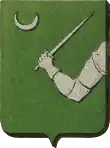 |
Coat of arms of the Mataranga (1391) The Mataranga were a noble Albanian family who settled in Sicilia from Epirus around the late 13th century, so mentioned in the work of Filadelfo Mugnos, titled "Teatro Genologico Delle Famiglie Nobili Titolate Feudatarie Ed Antiche Nobili Del Fidelissimo Regno Di Sicilia Viventi Et Estinte" (vol.2), published in 1655.[56] One notable heir, Giovanni Mataranga, was under the services of King Martino, from whom he obtained in compensation the territory of Morgana and the office of royal provisioner in the city of Castrogiovanni, wherein his lineage was consolidated by 1391. His son, Giacomo, would later acquire the fiefdom of Mantica, as evidenced from a medieval epitaph on his tomb, located in the church of S. Caterina of the said city. The family lineage met its end with Giacomo III around 1513.[57] The Mataranga coat of arms is described as follows:[58]
|
 |
Coat of arms of the Angeli (1525) Volume II of the antiquarian work by Pauli Angeli the Younger, the grandson of archbishop Pauli Angeli the Elder of Durazzo, published in Venetia in 1525, and titled: "Epistola Pauli Angeli: ad Sanctissimum in Christo patrem et Dominum Nostrum Dominum [D.N.D] Clementem diuina Prouidentia Papam septimum...", displays on page 40v the heraldic image of the Angeli family:[59]
|
 |
Coat of arms of the Alicorni (1673) The Alicorni were a noble Albanian family who fled the Ottoman advance of their homeland during Pope Pius II’s reign (r. 1458–1464). Seeking refuge in Milan, Pavia, Forlì, and eventually Rome, they attained high status through matrimonial alliances with other Italian nobility: among them the Ricci, Cayni, Trivulzi, Pusterla, Colli Aleotti, Leccilio, Colli Armentieri and Capranica. Messer Traiano was a Conservator (one of the three city councillors), who had his residence, today known as Palazzo Alicorni, erected in Borgo, not far from Piazza del Popolo, at the beginning of the sixteenth century. He left behind two sons, Giovanni Battista and Fabius, who were both appointed knights by the Pope. On July 3, 1584, Giovanni sold the palace to the French cardinal Matteo Contarelli, Datario of Pope Gregory XIII (r. 1572–85). The lineage ended at the dawn of the 20th century with Francesco, the last male heir of Traiano. The family coat of arms is featured in Stemmario Cremosano, dating from the 17th century:
|
 |
Coat of arms of the Cocco (17th century) The Cocco were a Venetian patrician family, originally from Durazzo in Albania. Members of the Consilium, they faced exclusion from the Maggior Consiglio of 1297. Other family members held important ecclesiastical positions in the Stato da Màr. In 1565, Gaetano Cocco founded the Cocco College in Padua. After the fall of the Serenissima, their nobility received recognition from the imperial Austrian government through Sovereign Resolutions on 11 November 1817. Their coat of arms is featured in a Florentine manuscript from the first half of the 17th century. The finely drawn illustration is followed by a detailed history of family events.[60] French chronicler Casimiro Freschot in his work "The Values of Venetian Nobility" sheds light on this family:[61]
|
 |
Coat of arms of the Durazzo (1757) The noble Durazzo family, originally from Albania, sought refuge in Genoa in 1388 to escape the Ottoman invasion of their homeland. Despite their common origins, members of this family gradually rose to prominence and by 1528, became affiliated with the "Albergo" Grimaldi, amassing wealth and influence. They constructed magnificent palaces and villas, curated art collections, established charitable organizations, and more. The family lineage diverged into two branches, giving rise to 9 doges (heads of state), senators of the Republic, ambassadors, bankers, governors, bishops, and even two cardinals.[62]
|
 |
Coat of arms of the Albani (1750) The Albani family, heralding from northern Albania, migrated to present-day Italy in 1468, led by Filippo de Lazii. They attained nobility status in various Italian cities such as Urbino, San Marino, Venetia, Genoa, Viterbo, Neapolis etc. Following the abolition of Seats in 1800, the family was recorded in the Neapolitan Libro d'Oro. Its most famous patron, Giovanni Francesco Albani (Pope Clement XI) was crowned head of the Catholic Church and ruler of the Papal States from 23 November 1700 until his death on 19 March 1721. Other notable members included Orazio Albani (1717 † 1792), who became prince of Soriano al Cimino and was recognized within the Neapolitan patriciate of Seggio di Portanova. Gian Francesco Albani (Rome, 1720 † therein, 1803), great-grandson of Pope Clement XI, held various ecclesiastical offices and in 1747 was appointed cardinal. The symbols in the family's coat of arms were acceded to the papal coat of arms, later found in the engraving work of Filippo Juvarra (c.1722), after designs by Francesco Fontana.[64]
The sculpted image of the papal coat of arms is found at the Cortile del Belvedere in the Vatican and the Fontana del Pantheon in Rome. |
 |
Coat of arms of the Zaguri (1786) The Zaguri were a noble Albanian family[65][66][67][68] that settled in Venetia from Cattaro around 1646. Its progenitor, Trifone Zaguri, had excelled during the Ottoman-Venetian War. Another family patron, Pietro I Antonio (1733-1806) was a distinguished poet, senator and architect, who designed and financed the façade of the Church of San Maurizio.[69] Marco Zaguri served as bishop of Ceneda and Vicenza from 1777 until his passing in 1810. The family resided at Palazzo Zaguri, now a cultural center, converted into an exhibition space with temporary art shows. The coat of arms is described as follows:
|
Moldavia & Romania
| Coat of arms | Description |
|---|---|
 |
Coat of arms of Vasile Lupu (1643) The coat of arms of the Voivode of Moldavia is found in the 1643 publication titled "Carte de Învățătură" (p. 138), commissioned in Iași by Prince Vasile Lupu of Moldavia, himself of Albanian stock.[70]
Prince Vasile Lupu traces his roots to the lesser-known Coci family, who had settled in Wallachia in the early 16th century, having migrated there from the Albanian settlement of Arbanasi, according to some sources.[71][72][73] The coat of arms is accompanied by the following poem:
|
.svg.png.webp) |
Coat of arms of the Ghica (1873) The Ghica family is one of Romania's oldest noble families whose members were active in Wallachia, Moldavia and the Kingdom of Romania from the 17th century through the late 19th century. Of esteemed Albanian lineage, the family produced 9 princes, 2 prime ministers and other prominent figures in the world of politics and literature. A noteworthy member of this family, influential writer and feminist Elena Ghica (pen name: Dora d'Istria) emblematized the Albanian national cause during the Renaissance period. Another family scion, Albert Ghica, a pretender to the Albanian throne, garnered recognition for his involvement during the Congress of Trieste and for providing monetary support to the Albanian Colony of Bucharest. The family coat of arms is described as follows:
The coat of arms shown here is a reproduction from a lithograph found in the 1873 book "Gli Albanesi in Rumenia", which chronicles the history of the Ghica family.[74] A later variant of the coat of arms is portrayed in a painting by George Demetrescu Mirea. |
Greece
| Coat of arms | Description |
|---|---|
 |
Coat of arms of the Dushmani (1925) During the 15th century, the noble Albanian family of Dushmani wielded authority over the Polati Minor region and beyond.[75] Lek Dushmani actively participated in the so-called League of Lezhë. Other members of this family served as stratiotes in the Peloponnese and the surrounding territories, which were under Venetian rule. A branch of the Dushmani, although residing in Corfu and being part of the merchant nobility of the island, were not initially registered in the Livre d'Or, as they belonged to other Venetian subjects in Morea.[76] Their coat of arms is depicted in the first edition of Eugène Rizo Rangabè's "Livre d'Or De La Noblesse Ionienne – Corfou" (p. 97):
|
Ottoman Empire
For over 500 years, Albanians were an integral and indispensable component of the Ottoman Empire, with far-reaching contributions that extended beyond politics, the economy, the military, administration and the judiciary. At least 32 accounted for grand viziers that served in this vast empire were of full or partial Albanian stock.
| Coat of arms | Description |
|---|---|
 |
Coat of arms of Koca Sinan Pasha (1596) Koca Sinan Pasha was an Ottoman-Albanian military figure and statesman who served for five terms as Grand Vizier of the Ottoman Empire. Appointed governor of the Egypt Eyalet in 1569, he was subsequently involved in the conquest of Yemen two years later, becoming known as Fātiḥ-i Yemen ("Conqueror of Yemen"). In 1594, he ordered the burning of Saint Sava's relics on the Vračar plateau. Contemporary Turkish historians note that he remained close to his heritage and would give those of Albanian stock preference to high-level positions within the empire.[77] The coat of arms attributed to his namesake can be found in the engraving work by Giacomo Franco, published in Venetia in 1596, and currently on display at the Metropolitan Museum of Art in New York City.[78] |
 |
Coat of arms of Köprülüzade Fazıl Ahmed Pasha (1690) Köprülüzade Fazıl Ahmed Pasha was an Ottoman-Albanian nobleman and statesman, belonging to the renowned Köprülü family, which produced six Grand Viziers for the Ottoman Empire. He served in the post of Grand Vizier himself from 1661 to 1676, after inheriting the title from his father, Köprülü Mehmed Pasha.[79] Köprülüzade Ahmed Pasha led the Ottoman Army in the Austro-Turkish War of 1663–64 and succeeded in destroying Novi Zrin in the northern part of the Kingdom of Croatia after nearly a month-long siege. Later on he would capture Candia (present-day Heraklion) from the Republic of Veneto in 1669, during the Cretan War.[80] His coat of arms is depicted in the engraving work by Nicolas de Larmessin, dated from 1690 and published in the Gallica Digital Library. |
Egypt
| Coat of arms | Description |
|---|---|
.svg.png.webp) |
Coat of arms of the Muhammad Ali dynasty (1867–1914) Muhammad Ali Pasha was an Ottoman-Albanian governor and the de facto ruler of Egypt from 1805 to 1848. The dynasty he established would go on to rule the country until the military coup of 1952. These arms were assumed during the reign of Khedive Ismail Pasha the Magnificent, when Egypt was elevated to a Khedivate.
The coat of arms took a slightly different form during subsequent periods of the reign. Altered once again towards the conclusion of Khedive Abbas Hilmi Il's rule, coinciding with Egypt's transition to a Sultanate. The final revision was implemented during King Fuad I's reign, when he proclaimed Egypt a Kingdom on the 15th of March, 1922.[81] |
Stratioti
Following the Ottoman conquest during the Middle Ages, the heraldic tradition became localized primarily throughout the coastal cities that fell under Veneto's rule. While Ulcin and Tivar succumbed in 1571, Parga, in present-day Greece, remained under Venetian control for extended periods (1447–1537; 1561–1797). The pinnacle of the city's prosperity was witnessed between 1572 and 1797. Its affiliation with Veneto facilitated the emergence of a class of captains and stratiotes, primarily engaged in furthering the Republic's interests. According to H. G. Ströhl, one of the notable families among the captains of Parga that possessed heraldic coats of arms was the Barbati.[82]
Republic of Veneto
| Coat of arms | Description |
|---|---|
 |
Coat of arms of the Boccali (1453) The Boccali family of stratiotes engaged in military and political pursuits within the Peloponnese during the years 1200–1216. Notable among their ranks was the Grand Duke Teodor Boccali (1453–1454), who commanded the Arvanites in the area.
An illustration of their coat of arms is first encountered alongside that of the Kastrioti in Du Cange's 1680 publication "Historia Byzantina duplici commentario illustrata: Prior familias ... Imperatorum Constantinopol. ... complectitur alter descriptionem urbis Constantinopolis",[83] and later featured in a work by Giffart in 1729. Du Cange, in his other work, titled "Illyricvm Vetvs & Novum Sive Historia", gives a brief profile of the Boccali family:[84]
|
 |
Coat of arms of the Crutta (17th century) The last kings of Poland were represented at the Sublime Porte by the Albanian lineage of the Crutta, whose genealogy in all likelihood goes back farther than the diploma of «amplissima nobilitas», issued to them at the beginning of the 17th century by La Serenissima, while they were still serving as stratiotes in Antivari (Dulcigno), on the coast of the Adriatic. The Crutta brothers, Pierre and Antonio, entered the services of King Stanisław Poniatowski, after he had reorganized his diplomatic mission in the Levant. The council meeting of 1775, in Warsaw, acknowledged their Venetian nobility and also granted them Polish nobility, that is to say... nativeness. Polyglots and men of letters, the Cruttas left behind several manuscripts related to philology. At the end of a very long and active career, after having survived the era of division within Poland and the Napoleonic Wars, Antonio Crutta passed away at the castle of Lewiczyn, in the home of his son-in-law, Count Bedlinski. His white marble tomb, decorated with the Venetian coat of arms of his family, survived with its Latin epitaph.[85] |
 |
Coat of arms of the Barbati (1880) The Barbati family name appears in Simeon Ljubić's 1880 work "Monumenta spectantia historiam Slavorum meridionalium: Commissiones et relationes venetaein," where a so-called Agostin Barbati is mentioned as the leggeri captain of Antivari.[86] In 1883, the Barbati are referenced in De Rada's publication Fiàmuri Arbërit among a list of Albanian families.[87]
Later we find the Barbati family name recorded in a catalog of coats of arms, having served as stratioti in Parga, at the time under Venetian rule. From the chronicles of Archduke Ludwig Salvator, published in 1907, the city numbered over 90 Albanian speaking families.[88]
|
Holy Roman Empire
| Coat of arms | Description |
|---|---|
.svg.png.webp) |
Armorial of Mercurio Bua (1498–1550) This armorial is attributed to the illustrious Count Mercurio Bua, for the causes declared, with each arms withdrawn as inserts within the shield:[89]
|
 |
Coat of arms of Giorgio Basta (1605) Born in Rocca, near Taranto, then Kingdom of Naples, into an Arbëresh family[90] that settled there from Epirus, Giorgio Basta (soon to become Count of Huszt and Marmaros) began his military career under the command of Prince Alexander of Parma, later serving in France. He eventually joined the imperial forces, gaining fame through victories over Sigismund Báthory and Bocskai, thus conquering parts of Transylvania and Upper Hungary. Basta became Field Marshal and Governor in Upper Hungary under Emperor Rudolf II, later being granted the title of Imperial Count in 1605. His marble tombstone, featuring a coat of arms and epitaph, was recently uncovered during renovation works at the Minoritenkirche church in Vienna, and is depicted in the Regasta Sepulchrorum, as recorded in a handwritten codex detailing his wartime achievements.[91]
|
Modern rule
| Coat of arms | Description |
|---|---|
 Great Arms   Diplomatic Seal |
Coat of arms of the Principality of Albania (1914) The earliest usage of state symbols is prescribed in the Organic Statute of Albania, drafted by the International Commission of Control. Chapter II, titled "The sovereign", in articles 7 and 18 states:[92]
The official newspaper of the Albanian government, Perlindja e Shqipëniës, in its opening page article titled "Speech of the King's in-law – Royal Court – Crown of Albania", dated 28 February 1914, gives an elaborate depiction of the coat of arms:[93]
An illustration of the coat of arms was published for the first time in an article by Eberhard Freiherr von Wechmar in the weekly illustrated newspaper Die Woche (1914), issue no. 10, p. 387. The extract from German reads:[94]
The coat of arms is once more featured in the form of a diplomatic seal on a royal invitation letter addressed to captain N. Thomson, the brother of Lt. Colonel L.W.Thomson. It bears the prince's coat of arms and that of the family of princess Sophie, both under the Albanian crown.[95] |
.svg.png.webp) Gold model  .svg.png.webp) Silver model |
Coat of arms of the Albanian Republic (1926–1929) The Coat of Arms of the Albanian Republic was introduced by decree-law "On the state coats of arms and official flags", dated 12 July 1926:[96]
Teki Selenica's encyclopedic guide book Shqipria më 1927, e illustruar (p. 125) provides an illustration of the coat of arms whereby the helm with the arms and banners is displayed in silver profile. The usage of the silver model is reaffirmed in official documents of the Ministry of Internal Affairs' secret office from the late fall of 1929.[97] |
 |
Coat of arms of the Albanian Kingdom (1929–1939) A decree-law in reference to the new Coat of Arms of the State was published in Fletorja Zyrtare, dated 14 August 1929 (p. 7–8). The redaction is from the original print using a form of old gheg, conventional for the time:[98]
DECREES: The approval and implementation of the Decree-law on the Coat of Arms and Flags of the State. Tirana, 8 August 1929. ZOG d. v. |
.svg.png.webp) Great Arms  .svg.png.webp) Lesser Arms |
Great arms of the Kingdom of Albania (1939–1943) On 3 June 1939, his Majesty the King Emperor, surrounded by his civil and military entourage, placed the «Constitutional Charter» into the hands of the President of the Ministerial Council, Vërlaci, expressing the paternal solicitude and affection for the Albanian people which inspired his determination. The said "Charter", made up of 54 articles grouped into 7 Titles, makes no mention yet of a coat of arms.[99] The arms of the Kingdom of Albania were promulgated by royal decree nr. 141, dated 28 September 1939. Summarized in seven article paragraphs, they are described as follows:[100] The greater arms is used: in the great seal of the State, on solemn occasions and in monumental decorations.
The lesser arms is used by the state administration. |
 Clockwise: (3) Simplified model used in promotional pamphlets; (4) Lifelike model used in coins; (5) Generally accepted model in use since 1948 |
State emblem/s of Communist Albania (1946–1992) Article 95 of the Statute of the People's Republic of Albania (1946) describes the state emblem as follows: Article 107 of the Constitution of the People's Socialist Republic of Albania (1976) maintains the same design phraseology as its precursor although expressed in a whole condensed sentence: Designed by acclaimed painter Sadik Kaceli, the emblem was initially adopted on 14 March 1946. It was readopted with minor amendments on 28 December 1976.[101] The shapes of the emblem have undergone several changes over the decades and are explained in chronological order below: Model (3): This image of the emblem is found in the Constitution of the People's Republic of Albania published in 1964 by the Albanian Committee for Cultural Relations and Friendship with Foreign Countries. The interweaving of the wheat stems is shown in right profile, meanwhile the wreaths are simplified in the shape of a rhombus or lozenge. The eagle's chest comes forth in a triangle-like posture, the minuscule eyes are rounded and there is a widening of the claws. The overall color scheme is lightly faded. Model (4): The emblem shown here was published by the nationally syndicated satire magazine Hosteni in its 1st issue of the 39th annual edition (956), dated 12 January 1983.[102] The lifelike image was used in the 500 L commemorative gold coin from 1969. A matching illustration of the emblem is featured on the cover page of the 1st issue, 27th annual edition, of the military magazine "10 Korriku" (1973). Model (5): Unlike with previous models, the wreath shown here is olive in color and appears more rounded, attuned to its soviet counterpart. Interestingly, the shape of the eagle is almost identical to the model found in the 1998 coat of arms. This exact emblem is seen in the 10 L silver coin minted in 1990. The only difference being the word MAJ which is printed as MAI, suggesting that it was likely reproduced in Italy. Model (6): The model of the emblem generally accepted as the official variant was published by "Albania today", a political and informative review, in its 1st issue (32) of the 7th annual edition (1977). This model has been used in banknotes and fiscal stamps since 1947.[103] On 7 April 1992, the Assembly formed after the early elections, in its afternoon session, voted to remove the communist emblem as the official symbol of the state including the removal of the star from the country's flag and established a parliamentary commission tasked with studying the proposal of a new emblem of the state.[104][105] |
.svg.png.webp) |
Coat of arms of the Republic of Albania (1992–1998) During the plenary session of 13 November 1992, members of the Assembly, having previously abolished the use of communist symbols as official representative symbols of the state, decided to adopt a new coat of arms of the Republic. Under proposal was the amendment of law no. 7491, dated 25.04.1991, "On the Main Constitutional Provisions" which propagated the inclusion of a new chapter titled "Flag, Coat of Arms and The Capital". Article 3 of the chapter, as read by the secretary of the assembly, stated the following:[106]
After several discussions and with no objections, the chairman of the assembly Pjetër Arbnori took the microphone to announce that article 3 was approved unanimously. The image of the coat of arms is found in various documents of the state archive and was once suspended at the main curtain wall in front of the rostrum of the national assembly. |
National defence
Military coats of arms

 Regional Support Brigade
Regional Support Brigade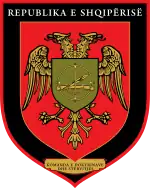 Training and Doctrine Command
Training and Doctrine Command Military Intelligence
Military Intelligence
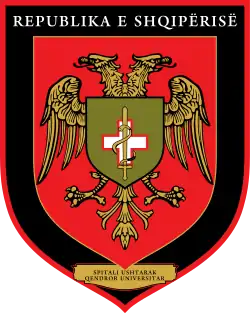
Police coats of arms

 Order Police
Order Police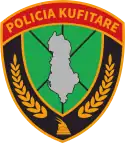
 Road Police
Road Police
Local administration
Counties
The symbolism in the coats of arms of counties in Albania is reflected in Article 5 of Law no. 139/2015, later amended by Law no. 38/2019, dated 20 June 2019 and titled "On Local Self-Governance", which classifies the county as a second level unit of local governance that represents an administrative-territorial unit, consisting of several municipalities with geographic, economic, social and common interests.[107]
Municipalities
Emblems of municipalities are required to incorporate and visually present, in a highly stylized approach and preferably in accordance with the formal rules of heraldry, the inherent elements and distinctive features that typify and symbolize any given municipality.[108]
Ecclesiastical coats of arms
The initial phase of clerical heraldry in Europe commenced around the year 1118, with the establishment of the Order of the Knights Templar. Its formal development occurred between 1417 and 1431, during the reign of Pope Martin V. Clerical heraldry in Albania endured throughout the Ottoman occupation, though it steadily waned due to the scarcity of prelates serving in the country. Whatever remained from that period was eradicated during communist rule, when a more atheist ideology was embraced. The earliest extant clerical coats of arms (or seals), recognized to this day, are attributed to Pjetër Zaharia and Nikoll Mekajshi.[109]
Coats of arms
| Coat of arms | Description |
|---|---|
 |
Coat of arms of Georgio Lapazaia (1575) Georgio Lapazaia was an apostolic prothonotary, mathematician and musician of Albanian stock, offspring of Danush and Maruccia, whom arrived in Monopoli from Durazzo after the fall of Constantinople. In 1508, he attained the title of sub-diaconate, eventually becoming Canon of the Monopoli Cathedral. Culturally versed in the Quadrivium, in 1532, Lapazaia composed an Antiphonary of processional nature, blending Gregorian chants with his own monophonic compositions. In 1542, he published a seminal treatise on Arithmetic and Geometry that saw numerous reprints until the late Eighteenth century.[110]
|
 |
Coat of arms of Pjetër Bogdani (1685) Pjetër Bogdani is the most prominent writer of early Albanian literature. Born in the village of Gur, in the northern Has region, he was ordained archbishop of Scupi in 1677. Bogdani is the author of Cuneus Prophetarum, published in Padua in 1685, considered the first prose work of substance written originally in Gheg. It features a frontispiece showing the image of himself kneeling down for a prayer, next to an altar with an episcopal coat of arms.[111]
|
 |
Coat of arms of Giovanni Francesco Albani (1689) The defining elements in the coat of arms of Pope Clement XI are found in a rare 1689 Cantelli da Vignola map of Albania, which incorporates most of present-day Montenegro and part of North Macedonia. The modern capital of Tirana appears as Terrana. Engraved in Roma by Giorgio Widman and printed for inclusion in De Rossi's "Mercurio Geografico", the copperplate features neatly hachured coastlines, pictorially represented mountains and forests, with clear and elegant typography. In the upper right corner is shown a dedicatory cartouche to Papal official Giovanni Francesco Albani who in 1700 would become Pope Clement XI. Originating from Albania, as the family name suggests, the Albani wielded significant authority and influence within the Church.[112]
|
 |
Coat of arms of the Xaverian College (1877) Facing the hardships and obstacles of antireligious fanaticism and attacks on local clergy, on October 17, 1877, in the presence of the old archbishop Pooten and Father Zef Lombardini, a new institution named the "Xaverian College of Jesuits" opened its doors in the city of Shkodër.[113]
|
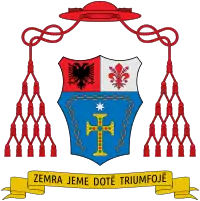
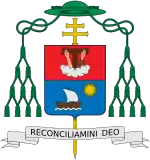
 Arjan Dodaj
Arjan Dodaj
 Gjergj Meta
Gjergj Meta Ottavio Vitale
Ottavio Vitale Simon Kulli
Simon Kulli Giovanni Peragine
Giovanni Peragine
Seals
| Seal | Description |
|---|---|
 |
Seal of Pjetër Zaharia (1395–1422) The original seal of the bishop of Sapa, Pjetër Zaharia, was discovered quite by chance, during excavation works in front of the Hvar Cathedral, on March 12, 1988. Preserved inside the Archives of the Bishopric of Hvar, the seal is made of copper. It has an oval shape with two poles that are slightly depressed, measuring 62x37x2x11 mm in size. On the side circle, in the form of a strip, is engraved in Latin with Gothic graphemes, the following text:[114]
which reads as:
|
 |
Seal of Nikoll Mekajshi (1592) Possibly descending from the settlement of Mjekës, present-day Elbasan, Nikoll Mekajshi was ordained bishop of Stefania and Benda in 1592. He played a pivotal role in the uprising of 1595, aimed to attack and liberate Croya from the Ottomans. From 1601 to 1602, Mekajshi participated as a leading figure at the Convention of Dukagjin. The Kingdom of Spain recognized him as ambassador of the Albanian clansmen (1602–1615). His Episcopal seal is preserved in the collection of Shtjefën Gjeçovi, borrowed for publication from Theodor Ippen, the Austrian consul in Shkodër, who had published it in his monograph in Vienna.[115] The seal representing the coat of arms has the following inscription in Latin: SIG•FR•NICOLAI•MECA•EPS•STEPHA•ET•BE
|
In society
| Coat of arms | Description |
|---|---|
 |
Konica's coat of arms (1905) The front page of the biweekly periodical Albania, published in Brussels by Faik Konica since 1896, features an illustration of a double-headed eagle, cradling a flame torch between its heads. A ribbon encircles the torch's handle, bearing the word “UNITAS” (meaning Oneness), symbolizing a call for unity among Albanians. The eagle's chest is shielded, and in the upper left corner hangs a black cross. A waving stripe stretches across the shield, wraps around the body, and ends on both sides of the eagle's neck, allowing its wings to remain partly unfurled. The text “ALBANIA” is prominently displayed. On the left side of the ribbon, it reads “ANNO,” and on the right, “1896.” Two claws grasp a lower ribbon, forming an arch, inscribed with the Latin text “UNGUIBUS ET ROSTRIS,” translating to “Claws and Beaks.” This graphic work of art was conceived by Belgian painter Paul Nocquet, under the guidance of Konica himself.[116] |
 |
Coat of arms of the Bogdani Society (1920) Among the cultural-artistic societies that emerged in the city of Shkodër during the post-independence years, the “Bogdani” society held a prominent place. Established by a group of young men who departed from the “Oratory of the Heart of Christ” to form their own organization, naming it after and being inspired by the patriotic ideals of Pjetër Bogdani, a renowned writer of old Albanian literature. In their programmatic document dated May 27, 1920, the society expressed its commitment "...out of love for the flourishing of the Albanian nation...".
Interestingly, the same coat of arms was adopted by the parish and members of the “Rozafat” society for various activities, including theatrical performances, carnival celebrations, and musical events.”[117] |
See also
References
- ↑ Lala, Etleva. "Kodiku i Laurencianës dhe dorëshkrimet e tjera të familjes fisnike të Engjëllorëve nga shek. XV e XVI". Gazeta Dielli. Retrieved 11 July 2022.
- ↑ Llukani, Andrea (2017). "Pavioni i Mesjetës dhe Këndi i Pashallëqeve të Mëdha Shqiptare". Katalog: 18–19.
- ↑ Zheku, Koço (1984). Gurët e mbishkruar të Kishës së Ndërfandës (2 ed.). Tiranë: Akademia e Shkencave, Qendra e Kërkimeve Arkeologjike. pp. 219–225.
- ↑ Zamputi, Injac (1984). "Rindërtimi i mbishkrimit të Arbërit dhe mundësitë e reja për leximin e tij". Iliria. 14 (2): 207–218. doi:10.3406/iliri.1984.1332.
- ↑ Ippen, Theodor (1907). "Denkmäler verschiedener Altersstufen in Albanien". Zobodat: 13.
- ↑ Bunguri, Adem. "Stema e Gropajve në Maqellarë të Dibrës së Epërme". rrugaearberit.com. Retrieved 5 November 2021.
- ↑ Buda, Aleks (1985). Fjalori Enciklopedik Shqiptar. Tiranë: Akademia e Shkencave e RPSSH. p. 212.
- ↑ Petronio, Prospero (1968). Memorie sacre e profane dell'Istria. Trieste: Tip. G. Coana. pp. 110–111.
- ↑ Pilika, Dhimitri (1966). "Shqiponja Arbërore si Simbol i Dukagjinëve". YLLI. 7 (6): 20–21.
- ↑ Francus, Demetrius (1584). Gli Illustri et gloriosi gesti, et vittoriose imprese fatte contra Turchi; dal Sign. Giorgio Castriotto detto Scanderbeg. National Library of Naples: presso Altobello Salicato alla libraria della Fortezza. p. 31.
- ↑ Dizionario Storico-Portatile di Tutte Le Venete Patrizie Famiglie. Venetia: Giuseppe Bettinelli. 1780. pp. 50–51.
- ↑ Müntz, Eugène (1878). Les Arts à la cour des Papes pendant le XVe et le XVIe siécle. Olms. p. 253. ISBN 9783487413006.
- ↑ "Ancora sull'origine italiana degli antichi principi di Albania". Rivista del Collegio Araldico (11): 568. 1913.
- ↑ Rubčić, Stanislav (1635–1662). Fojnica Armorial. p. 20.
- ↑ Zeqo, Moikom (8 September 2019). "Aleksandri i Madh sipas Statutit të Shkodrës". Shqiptarja.com.
- ↑ Nadin, Lucia (2002). Statuti di Scutari: della prima metà del secolo XIV con le addizioni fino al 1469. Roma: Viella. p. 245. ISBN 9788883340420.
- ↑ Du Cange, Charles Du Fresne (1746). Illyricum vetus & novum, siue, Historia regnorum Dalmatiae, Croatiae, Slavoniae, Bosniae, Serviae, atque Bulgariae. Typis Hæredum Royerianorum. p. 131.
- ↑ Siebmacher, Johann (1873). Wappenbuch (4 ed.). Nürnberg: Verlag von Bauer und Raspe. p. VII.
- ↑ Rubčić, Stanislav (1635–1662). Fojnica Armorial. p. 21.
- ↑ Georg von Hann, Johann (1854). Albanesische Studien (2 ed.). Wien: Verlag von Friedrich Mauke. p. 119.
- ↑ Ippen, Theodor (1907). "Denkmäler verschiedener Altersstufen in Albanien". Zobodat: 67–69.
- ↑ Ippen, Theodor (1907). "Denkmäler verschiedener Altersstufen in Albanien". Zobodat: 31–33.
- ↑ Varfi, Gjin (2000). Heraldika Shqiptare. Shtëpia Botuese "Dituria". p. 32. ISBN 9789992731857.
- ↑ Scodrensis, Marini Barletii (1508). HISTORIA DE VITA ET GESTIS SCANDERBEGI EPIROTARVM PRINCIPIS (PDF). p. XV.
- ↑ Biemmi, Giammaria (1756). ISTORIA DI GIORGIO CASTRIOTO DETTO SCANDER BEGH. p. 22.
- ↑ Schiró, Giuseppe (1904). Gli Albanesi e la Questione Balkanica. Istituto Orientale di Napoli.
- ↑ Pilika, Dhimitri (1962). "Searching for "ALBANICA" through foreign archives and libraries..."". Revista Ylli (11): 26–27.
- ↑ Varfi, Gjin (2000). Heraldika Shqiptare. Tiranë: Shtëpia Botuese "Dituria". p. 49. ISBN 99927-31-85-0.
- ↑ Jurlaro, Rosario (1970). I Musachi despoti d'Epiro: "in Puglia a salvamento". Ed. del Centro librario. p. 47.
- ↑ Guadalupi, Francesco. "Madonna della Misericordia – Mesagne (Br)". Brundarte. Retrieved 19 June 2021.
- ↑ Васильев, Андрей. "КАКИМ БЫЛ ГЕРБ КОМНИНОВ?". mangup.su. Retrieved 30 October 2022.
- ↑ Unknown (1550). Insignia ... VII. Insignia Venetorum nobilium II (A-IP) - BSB Cod.icon. 272. Bayerische Staatsbibliothek. p. 205.
- ↑ Dedaj, Martin. "Historia e dhimbshme e familjes Gjonmarkaj". KultPlus. Retrieved 28 June 2020.
- ↑ Žefarović, Hristofor; Mesmer, Toma (1972) [1741]. Dinko Davidov (ed.). Stemmatographia (in Church Slavic). Novi Sad: Gallery of Matica Srpska. p. 29.
- ↑ Ritter, Paulo (27 April 1701). Stemmatografia sive armorum Illyricorum delineatio, descriptio et restitutio (PDF). Vienna. p. 11.
- ↑ Galvani, Federico Antonio. Il Re D'Armi di Sebenico (2 ed.). Venetia. p. 95.
- ↑ von Rosenfeld, Carl Georg Friedrich Heyer (1873). Wappenbuch des Königreichs Dalmatien. Nürnberg: Verlag von Bauer und Raspe. p. 181.
- ↑ Sturdza, Mihail Dimitri (1983). Grandes familles de Grèce: d'Albanie et de Constantinople. Paris: Chez l'auteur. p. 190.
- ↑ Sansovino, Francesco (1654). Historia universale dell'origine, guerre, et imperio de' Turchi (1 ed.). Hendrik Conscience Heritage Library: Sebastiano e Gio la Noù. p. 274.
- ↑ Jaques, Edwin E. (2009). The Albanians An Ethnic History from Prehistoric Times to the Present (1 ed.). University of Michigan: McFarland. p. 193.
- ↑ "Bulletin scientifique". Le Conseil. 19 (7–12). 1983.
- ↑ Du Cange, Charles Du Fresne (1746). Illyricvm Vetvs & Novum Sive Historia. Typis Hæredum Royerianorum. p. 139.
- ↑ Grio, Paolo; Bernich, Cristina (2003). "Bratti (Brati)". Blasonario Giuliano: 228.
- ↑ Cherini, Aldo (2001). Bassorilievi Araldici ed Epigrafi di Capodistria. p. 148.
- ↑ Archivo Storico Italiano (5 ed.). Ghent University: Gio. Pietro Vieusseux. 1843. p. 326.
- ↑ Istorijski Glasnik. 1969. p. 30. Retrieved 24 April 2013.
За Стефана Црнојевића (помиње се од 1426. годи- не),
- ↑ Koliqi, Ernest (1964). "Le Pleiadi". Shejzat. 11–12: 505.
- ↑ "Pjetër Gjura". catholic-hierarchy.org. Retrieved 2 September 2023.
- ↑ Galvani, Federico Antonio. Il Re D'Armi di Sebenico (1 ed.). Venetia. p. 378.
- ↑ Jireček, Konstantin (1904). Die Romanen in den Städten Dalmatiens während des Mittelalters. p. 43.
- ↑ Razzi, Serafino; Ferretti, Lodovico (1903). La storia di Ragusa. University of California: A. Pasarić. p. 6.
- ↑ Malaj, Edmond (2019). "Në gjurmë të familjeve fisnike raguzane". Akademia e Studimeve Albanologjike: 17–18.
- ↑ Bollettino (3–4 ed.). University of California: Centro di studi filologici e linguistici siciliani. 1955. p. 267.
- ↑ Valentini, Giuseppe (1973). Acta Albaniae Veneta saeculorum XIV et XV. Typis Josephi Tosini. p. 37.
- ↑ Razzi, Serafino (1595). La Storia di Raugia. Austrian National Library: Vicentio Busdraghi. p. 2.
- ↑ Mugnos, Filadelfo (1655). Teatro Genologico Delle Famiglie Nobili Titolate Feudatarie Ed Antiche Nobili Del Fidelissimo Regno Di Sicilia Viventi Et Estinte (2 ed.). Bavarian State Library: Coppola. p. 201.
- ↑ Dorsa, Vincenzo (1847). Su gli Albanesi: ricerche e pensieri. Napoli: Tipografia Trani. p. 72.
- ↑ Gravina, V. Palizzolo (1875). Il Blasone in Sicilia. Palermo: Visconti & Huber. p. Tav.49.
- ↑ Ahmeti, Musa (27 February 2022). "ZBULOHET NJË VEPËR AUTORIALE ANTIKUAR E PAL ENGJËLLIT NGA VITI 1524". Gazeta Dielli.
- ↑ Schröder, Franz (1830). Repertorio genealogico delle famiglie confermate nobili e dei titolati nobili esistenti nelle provincie venete... University of Princeton: Alvisopoli. p. 241.
- ↑ Freschot, Casimiro (1682). Li Pregi della Nobiltà Veneta. National Library of Naples: Andrea Poletti. p. 274.
- ↑ "Durazzo Marcello". Storia e Memoria di Bologna. Retrieved 18 August 2023.
- ↑ Anonymous (1757). Liber Nobilitatis Serenissimæ Reip. Genuensis (1 ed.). Biblioteca Civica Berio. p. 321.
- ↑ "Famiglia Albani". nobili-napoletani.it. Retrieved 19 August 2023.
- ↑ Dizionario Storico-Portatile di Tutte Le Venete Patrizie Famiglie. Venetia: Giuseppe Bettinelli. 1780. p. 161.
- ↑ Combatti, Bernardo e Gaetano (1846). Nuova Planimetria della citta di Venezia (2 ed.). Austrian National Library: Naratovich. p. 190.
- ↑ Tommaseo, Niccolò (1863). Geografia Storica Moderna Universale. Biblioteca Santa Scholastica: F. Pagnoni. p. 1028.
- ↑ Fugagnollo, Ugo (1969). Venezia così – Le sette chiavi per conoscere la città. University of Wisconsin: U. Mursia. p. 231.
- ↑ "Pietro Zaguri". British Museum. Retrieved 3 September 2023.
- ↑ Lupu, Vasile (1643). Carte de Învățătură. Iași. p. 138.
- ↑ Djuvara, Neagu (2016). A Brief Illustrated History of Romanians. Humanitas SA. p. 223. ISBN 9789735053819.
- ↑ Wasiucionek, Michal (2019). The Ottomans and Eastern Europe. Bloomsbury Publishing. p. 120. ISBN 9781788318570.
- ↑ Ogden, Alan (2021). Revelations of Byzantium The Monasteries and Painted Churches of Northern Moldavia. Histria Books. p. 19. ISBN 9781592110681.
- ↑ d'Istria, Dora (1873). Gli Albanesi in Rumenia. Firenze: Estratto dalla Rivista Europea.
- ↑ Buda, Aleks (1985). Fjalori Enciklopedik Shqiptar. Tiranë: Akademia e Shkencave e RPSSH. p. 220.
- ↑ Rizo Rangabè, Eugène (1925). Livre d'Or De La Noblesse Ionienne – Corfou (I ed.). Maison D'Editions "Eleftheroudakis". p. 22.
- ↑ Elsie, Robert (2012). A Biographical Dictionary of Albanian History. I.B. Tauris. pp. 416–. ISBN 978-1780764313.
- ↑ Editorial Staff. "Sinan Bassa, from Effigie naturali dei maggior prencipi et piu valorosi capitani di questa eta con l'arme loro". Metropolitan Museum of Art. Retrieved 30 August 2023.
- ↑ Finkel, Caroline (2005). Osman's Dream: The Story of the Ottoman Empire, 1300-1923. New York: Basic Books. pp. 278, 281. ISBN 978-0-465-02396-7.
- ↑ Wurm, Heidrun (1971). Der osmanische Historiker Ḥüseyn b. Ğafer, genannt Hezārfenn, und die Istanbuler Gesellschaft in der zweiten Hälfte des 17. Jahrhunderts. Freiburg im Breisgau: Klaus Schwarz Verlag. p. 52. [in German]
- ↑ Karkegi, Max. "Heraldry of Egypt". hubert-herald.nl. Retrieved 18 August 2023.
- ↑ Varfi, Gjin (2000). Heraldika Shqiptare. Tiranë: Shtëpia Botuese "Dituria". p. 73. ISBN 99927-31-85-0.
- ↑ Du Cange, Charles du Fresne (1680). Historia Byzantina duplici commentario illustrata: Prior familias ... Imperatorum Constantinopol. ... complectitur alter descriptionem urbis Constantinopolis. Biblioteca Estatal de Baviera. p. 267.
- ↑ Du Cange, Charles Du Fresne (1746). Illyricvm Vetvs & Novum Sive Historia. Typis Hæredum Royerianorum. p. 140.
- ↑ Sturdza, Mihail Dimitri (1983). Grandes familles de Grèce: d'Albanie et de Constantinople. Paris: Chez l'auteur. p. 577.
- ↑ Ljubić, Simeon (1880). Monumenta spectantia historiam Slavorum meridionalium: Commissiones et relationes venetae (11 ed.). p. 277.
- ↑ de Rada, Girolamo (1883). "Monografia di Piana de' Greci". Fìamuri Arbërit. 1 (12): V.
- ↑ Salvator, Ludwig (1907). Parga (1 ed.). Prag, Heinrich Mercy. p. 34.
- ↑ Sathas, Konstantinos (1867). Hellenika anekdota (1 ed.). University of Crete Library: Τύποις του Φωτός. pp. 5–9.
- ↑ Hanlon, Gregory (2019). The Hero of Italy. OUP Oxford. p. 105. ISBN 9780192586285.
- ↑ Editorial Staff. "Basta". Arcanum. Retrieved 30 August 2023.
- ↑ von Thallóczy, Ludwig (1916). Illyrisch–Albanische Forschungen. München und Leipzig: Verlag Von Duncker & Humblot. pp. 174–175.
- ↑ "Speech of the King's in-law – Royal Court – Crown of Albania". No. 14. Perlindja e Shqipëniës. 28 February 1914.
- ↑ Neubecker, Ottfried. "Die Geschichte des Wappen von Albanien". e-periodica.ch. Retrieved 24 February 2021.
- ↑ Lame, Artan (2012). Princi i Shqiptarëve. Botimet Toena. p. 114. ISBN 978-99943-1-746-2.
- ↑ "Dekret-ligj "Mbi stemat e shtetit e flamurët zyrtar"" (PDF). Fletorja Zyrtare. 5 (112): 1. 22 July 1926.
- ↑ Selenica, Teki. Shqipria më 1927 (e illustruar). p. 573.
- ↑ "Dekret-Ligj për Flamurin dhe Stemën e Shtetit" (PDF). Fletorja Zyrtare: 7–8. 14 August 1929.
- ↑ Annuario dell Regno di Albania (PDF). Milano: Casa Editrice Ravagnati. 1940. p. 26.
- ↑ "Stemat dhe Vulat e Shtetit" (PDF). Fletorja Zyrtare. XVIII: 302. 3 October 1939.
- ↑ "National Emblem of the People's Socialist Republic of Albania" (PDF). Albania Today. 7 (1). 1977.
- ↑ "Vajtimi i Korbave". Revista Hosteni. 39 (1). 12 January 1983.
- ↑ "Kartmonedha të emetuara në vitin 1947". bankofalbania.org. Banka e Shqipërisë. Retrieved 23 December 2022.
- ↑ Punime të Kuvendit (PDF). 1 (in Albanian). Tirana: Parliament of Albania. 2009. pp. 24‒44.
- ↑ Dervishi, Kastriot (14 April 2019). "1992/Si u hoq ylli i kuq sovjetik nga flamuri kombëtar dhe stema shtetërore". www.55news.al (in Albanian). Retrieved 2021-11-23.
- ↑ Punime të Kuvendit (PDF). 6 (in Albanian). Tirana: Parliament of Albania. 2009. pp. 2163‒2168.
- ↑ "Ligj Nr. 139/2015 "Për Vetëqeverisjen Vendore"". Qendra e Botimeve Zyrtare (Neni 5). 20 June 2019.
- ↑ Vehbiu, Ardian (23 March 2018). "Stemat e Dëshirës". peisazhe.com. Retrieved 23 March 2018.
- ↑ Varfi, Gjin (2000). Heraldika Shqiptare. Tiranë: Shtëpia Botuese "Dituria". p. 68. ISBN 99927-31-85-0.
- ↑ Morgante, Domenico (1991). La musica in Puglia tra rinascite e rivoluzioni. Fondazione N. Piccinni. p. 70.
- ↑ Varfi, Gjin (2000). Heraldika Shqiptare. Shtëpia Botuese "Dituria". p. 71. ISBN 9789992731857.
- ↑ Cantelli da Vignola, Giacomo (1689). Mercvrio Geografico. Roma: De Rossi. p. 163.
- ↑ "Themelimi i Kolegjit Saverian në Shkodër më 1877". Vatican News. Retrieved 17 October 2021.
- ↑ Ahmeti, Musa (6 August 2020). "Zbulohet vula e Ipeshkvit të Sapës Pjetër Zaharisë nga viti 1422 në Hvar të Kroacisë". Gazeta Dielli.
- ↑ "Vula Peshkopale e Nikollë Mekajshit, e ruajtur në koleksionin e Shtjefën Gjeçov Kryeziut". Koha. Retrieved 17 October 2019.
- ↑ Tahiri, Kolë (16 January 2016). "Prezantim i Revistës "Albania" të Faik Konicës". Gazeta Dielli.
- ↑ Zadeja, Tonin (23 May 2023). "Shoqëria kulturore-artistike "Bogdani"". Phoenix (4): 89–95.




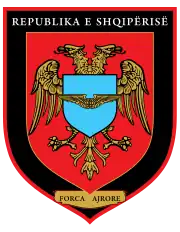
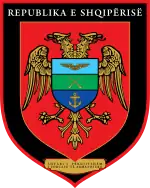

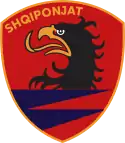
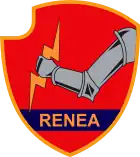








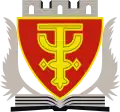











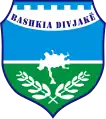




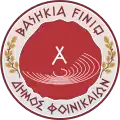




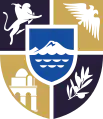

.svg.png.webp)





